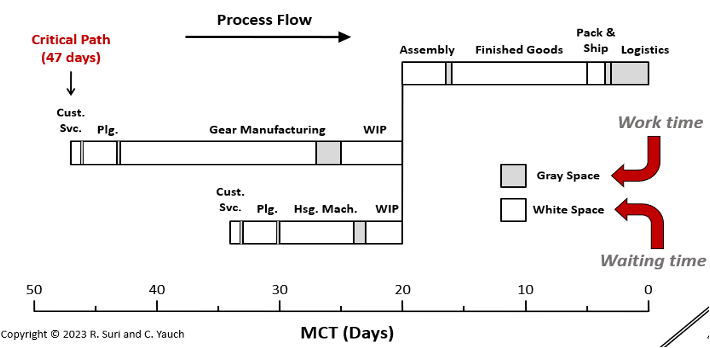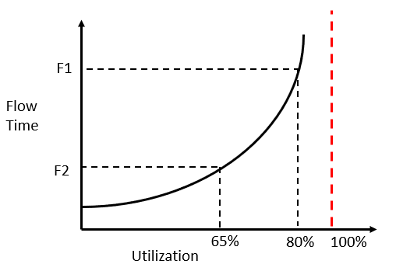Written by: Charlene Yauch, director of the Center for Quick Response Manufacturing
Quick Response Manufacturing (QRM) was invented by Rajan Suri in the 1990s. The primary goal is relentless reduction of lead time (internal process flow times). Thus, application of these concepts enables a company to compete on speed, flexibility, and agility.
Here are ten important things you should know about it:
- QRM is particularly effective for companies making low-volume, high-variability or custom-engineered products. Many companies with a wide array of products in make-to-order or engineer-to-order systems struggle with long flow times. The QRM methodology was designed specifically for this type of production scenario. Some Lean concepts, such as takt time, Kanban, and production smoothing do not work well in these contexts. QRM helps manage the high level of production variety, while ensuring fast flow through the office and shop floor.
- Variability can be characterized as dysfunctional or strategic. Dysfunctional variability is the kind that arises from operational problems, such as rework, errors, machine downtime, long setup times, absenteeism, etc. Strategic variability is the kind that exists to make customers happy, such as offering different product variations and options or even fully customized products. In the QRM methodology, your aim is to reduce the dysfunctional variability as much as possible and exploit the strategic variability by establishing a production and fulfillment system that can quickly and effectively deliver a wide variety of products.
- Manufacturing critical-path time (MCT) is a metric that identifies waste in the system. MCT measures the typical flow time through a manufacturing system, including time spent waiting for machines or people and time spent in inventory locations. The time is divided into two categories: gray space for when work is being done on the product and white space for when there are disruptions or delays that can be avoided or reduced. QRM’s goal is to reduce the MCT (total elapsed process flow time), with emphasis on the white space.

- QRM encourages small-batch flow but not necessarily single-piece flow. Small batches can generally flow through a manufacturing system faster than large ones, but if there is a setup time on a machine, you do not want to set the batch size to be too small, which leads to too much time being spent on setting up the machine. There is an optimal batch size relative to flow time, which ensures the batch size is not too big or too small. Of course, efforts can still be made to reduce the setup time, which would then establish a new smaller optimal batch size for the system.
- Organizational restructuring is generally necessary. Many companies are organized by functional departments, both on the shop floor and in the office. This means that jobs or orders flow through many departments and often have long waits before they get attention. To achieve faster flow, the organization must be restructured from functional departments into a cellular structure. Each cell is designed to perform a sequence of operations for a Focused Target Market Segment (FTMS) or product family.
- It is important to cross-train and empower the cell team members. Workers are not managed the traditional way in a cellular structure. Workers need to be cross-trained to make them more flexible at covering different tasks that need to be done to keep the jobs/orders moving. Workers also need to be empowered to make decisions about the work being done within the cell, which also contributes to faster flow and leads to greater accountability for the results.
- Creating spare capacity on resources speeds up the flow. Traditional manufacturing metrics include utilization and efficiency. Pushing these two metrics toward 100% has a negative impact on systemwide flow time, but many companies still employ these metrics on a regular basis. Instead, companies should plan for 15 to 25% spare capacity on resources to ensure that fast flow can occur. Establishing this spare capacity will allow the variation in the system to be managed without building large queues (or backlogs) and without having to regularly work overtime to catch up. The image below shows the typical relationship between flow time and resource utilization; reducing the utilization from 80% to 65% results in a significant reduction in flow time (from F1 to F2).

- The POLCA production control system can be used to coordinate cell-to-cell flow. POLCA is a hybrid push-pull system that uses an ERP (MRP) system to create authorization dates when jobs can be launched into particular work cells but also uses cards to control the total number of jobs that are being worked on in order to reduce congestion. The system ensures that upstream cells are working on jobs that will be able to flow when they arrive downstream.
- Cell restructuring works in the office too. Office activities like quoting and order processing can account for more than 50% of lead time and more than 25% of costs. To improve the office, the same kind of organizational restructuring that works on the shop floor can be used. Quick Response Office Cells (Q-ROCs) can be established to focus on a product family (or Focused Target Market Segment, FTMS). The resources are co-located and accomplish a sequence of activities. The workers are cross-trained and given authority to make decisions.
- Lead time reduction can be used to drive other performance improvements. Focusing on the reduction of lead time (MCT) within a company’s internal processes can result in a wide array of other beneficial outcomes, including better quality (due to faster feedback loops, cross-trained workers, and small batch flow), improved on-time delivery, and lower operational costs (particularly in the overhead category). It makes a company more flexible and agile to operate successfully in a dynamic environment. Time-based decision making can be the catalyst to achieving desired business outcomes and achieving a significant competitive advantage.
Additional Sources:
- QRM Center Website: https://qrm.engr.wisc.edu/
- Quick Response Manufacturing: A Companywide Approach to Reducing Lead Times, Rajan Suri, 1998, Productivity Press.
- It’s About Time: The Competitive Advantage of Quick Response Manufacturing, Rajan Suri, 2010, Productivity Press.
- MCT Quick Reference Guide, Rajan Suri, 2014, Suri Consulting and Seminars LLC.
- The Practitioner’s Guide to POLCA: The Production Control System for High-Mix, Low-Volume and Custom Products, Rajan Suri, 2018, Productivity Press.